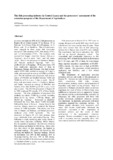The fish processing industry in Central Luzon and the processors' assessment of the extension program of the Department of Agriculture
- Global styles
- MLA
- Vancouver
- Elsevier - Harvard
- APA
- Help
Share
Abstract
A survey was done in 1992 of 242 fish processors in Region III or Central Luzon: 57 in Bataan, 39 in Bulacan, 24 in Nueva Ecija, 45 in Pampanga, 41 in Tarlac, and 36 in Zambales. The fish processors were engaged in three major fish processing enterprises: fish smoking (52%), fish drying (17%), and fish fermentation (31%). The products were smoked fish ‘tinapa’, dried fish ‘daeng’, fish paste ‘bagoong’, rice-fish paste ‘buro’, and fish sauce ‘patis’. Most of the processors in Zambales, Bataan, and Bulacan produced bagoong; ‘buro’ was produced only in Pampanga. Of the processors, 105 were small-scale operators, most of them in Pampanga, Bataan, and Bulacan, who had average capital of P11,000, worked an average of 3 days a week, and processed an average of 5,000 kg of fish a year. The 90 medium-scale processors had average capital of P20,000 and handled between 5,000 and 20,000 kg of fish a year, 5 days a week. The 47 large-scale processors, mostly in Zambales, Bataan, and Tarlac, invested an average of P94,000, and handled more than 20,000 kg of fish a year, seven days a week. The 242 fish processors in Region III in 1992 employed 501 people, 47% of them family members. The total production of processed fish products was about 73,000 kg a month, including about 21,511 kg ‘tinapa’, 4,790 kg ‘daeng’, and 46,634 kg ‘bagoong’. Processors in Zambales fermented the most fish, about 23,000 kg/month, followed by those in Bulacan. Among those in fish smoking, Bataan processors produced the biggest volume of 5,900 kg/month. Fish drying was done only in Bataan and Bulacan, and Bataan processors produced about 2,800 kg/month. The fish processors in Region III sold their produce three ways: wholesale, retail, and contract buying. They followed a simple marketing plan, using outlets in nearby towns and cities, including Metro Manila. For six months of operation, the cost was lowest in fish smoking and highest in fish drying. Gross sales was also lowest in fish smoking, but highest in ‘bagoong’-making. Net profit was lowest in fish smoking and highest in ‘bagoong’-making. Return on investment was 38% in fish smoking, 41% in ‘bagoong’-making, but only 19% in fish drying. More than one-half of the processors earned incomes of P20,000–35,000 a month, one-fifth earned less, but one-fourth earned more.
Fish processors in Region III in 1992 were on average 46 years old; nearly 80% were 26–55 years old and only two were younger than 26 years. There were more women than men in fish processing, particularly in Bataan, and about 93% were married. The respondents had formal education, but 60% did not go beyond elementary school. The respondents had considerable experience in fish processing, 60% of them having been in the business for 5–20 years, and 19% of them for even longer. Many reported household expenditures of P1,000–3,000 a month, but some also as high as P6,000–7,000 a month. The processors owned household appliances and furniture, and a few owned motorized boats.
The Department of Agriculture provided extension services and credit to fish processors in Region III. Services included technical assistance, direct consultation, field visits, lectures, demonstrations, training, seminar, and preparation of feasibility study when availing of loans. Most fish processors in Bulacan considered extension services important, but most of those in Nueva Ecija were indifferent to extension services, apparently because they already had the needed knowledge and skills. In Pampanga, the older processors and those with greater investment considered extension services very important. In Zambales, processors with more experience required less extension services. In Bataan, gender, education level, investment, civil status, and income significantly influenced the processors’ assessment of the importance of extension services and the extent of their participation in the government’s extension program. Women considered it very important to avail of extension services, especially those who were married and those with little formal education.
Suggested Citation
Morata, M. S. (2008). The fish processing industry in Central Luzon and the processors’ assessment of the extension program of the Department of Agriculture. In T. U. Bagarinao (Ed.), Research Output of the Fisheries Sector Program (Vol. 2. Reports on Fisheries and Aquaculture, pp. 202-212). Quezon City, Philippines: Bureau of Agricultural Research, Department of Agriculture.
Type
Book chapterISBN
9718511776


